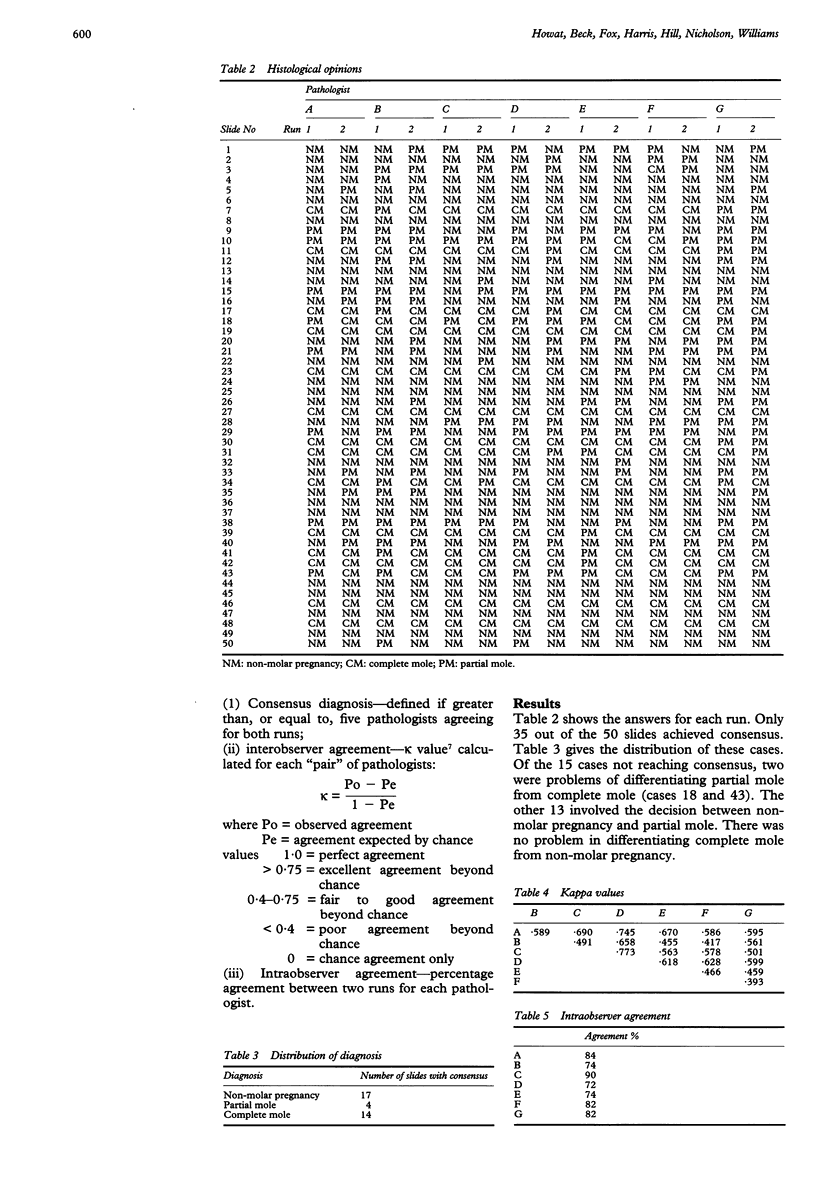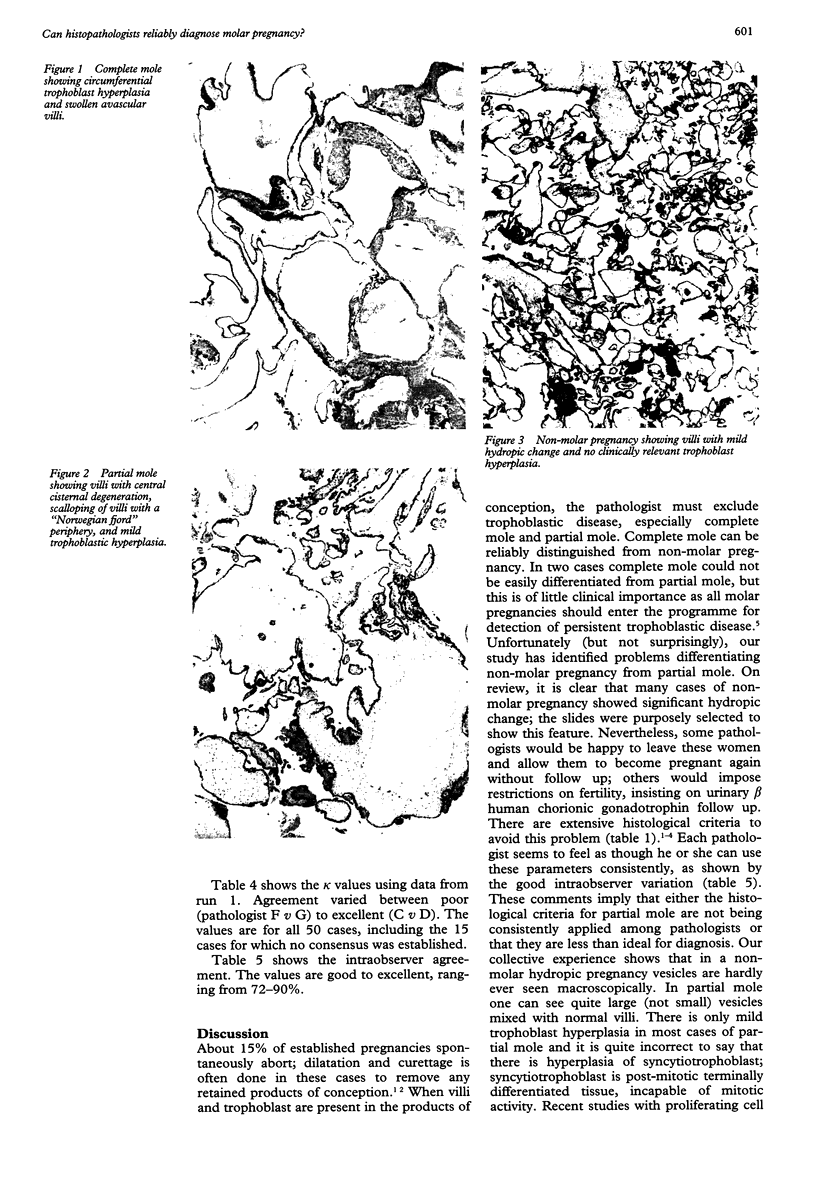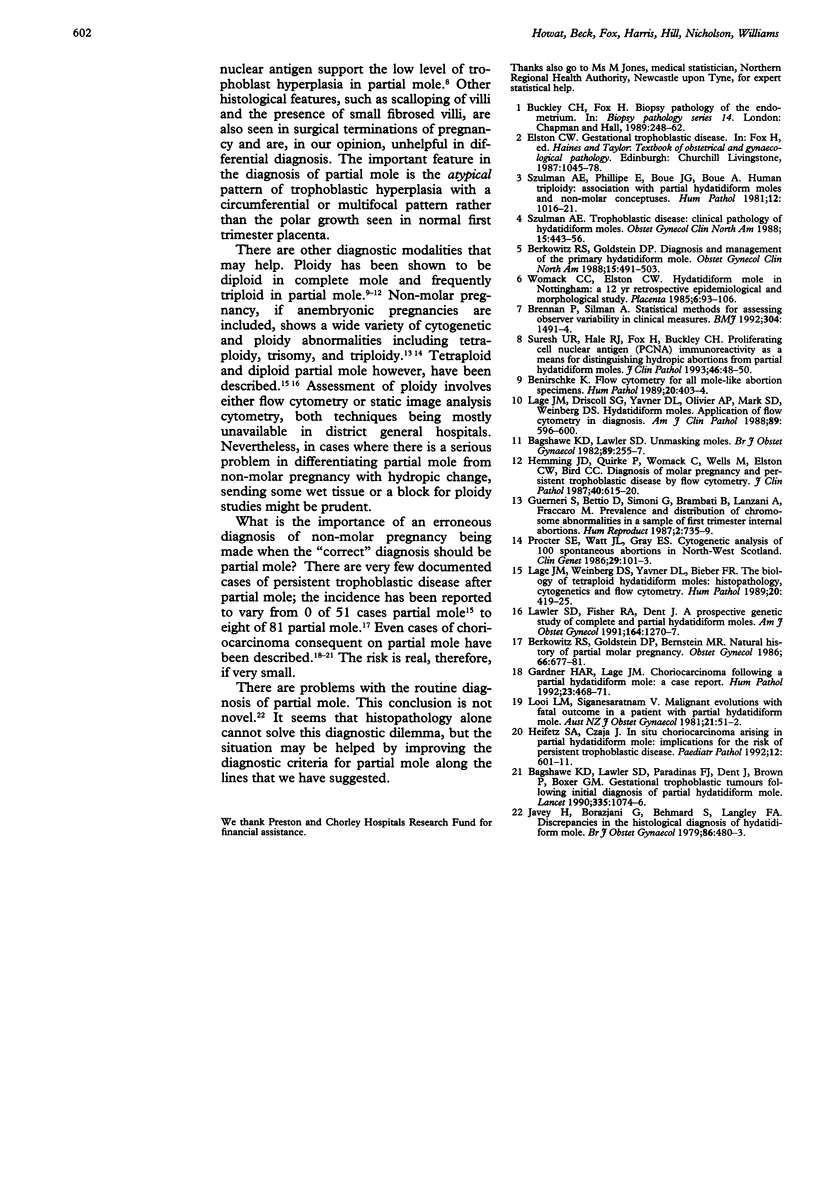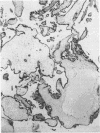Abstract
AIMS--To assess the degree of difficulty in diagnosing partial mole by analysing intraobserver and interobserver agreement among a group of pathologists for these diagnoses. METHODS--Fifty mixed cases of partial mole, complete mole, and non-molar pregnancy were submitted to seven histopathologists, two of whom are expert gynaecological pathologists; the other five were district general hospital consultants, one of whom works in Australia. These participants gave each slide a firm diagnosis of either partial mole, complete mole, or non-molar pregnancy. Some 12 months later, the slides were recorded and again submitted for a second diagnostic round to assess intraobserver as well as interobserver agreement. Standard histological criteria for each diagnostic category were circulated with the slides. RESULTS--kappa statistics showed that complete mole could be reliably distinguished from non-molar pregnancy, but neither non-molar pregnancy nor complete mole could be easily differentiated from partial mole. In only 35 out of 50 cases was there agreement between five or more of the seven participants. Agreement between the expert gynaecological pathologists was no better than for others in the group. Interestingly, the intraobserver agreement for each pathologist was good to excellent. CONCLUSIONS--These results imply that the reported histological criteria are either not being applied consistently or that they are lacking in practical use. An atypical growth pattern of trophoblast, rather than the polar accentuation seen in normal first trimester pregnancies, seems to be the important diagnostic histological feature for partial mole. Ploidy studies might also help with problem cases.
Full text
PDF



Images in this article
Selected References
These references are in PubMed. This may not be the complete list of references from this article.
- Bagshawe K. D., Lawler S. D., Paradinas F. J., Dent J., Brown P., Boxer G. M. Gestational trophoblastic tumours following initial diagnosis of partial hydatidiform mole. Lancet. 1990 May 5;335(8697):1074–1076. doi: 10.1016/0140-6736(90)92641-t. [DOI] [PubMed] [Google Scholar]
- Bagshawe K. D., Lawler S. D. Unmasking moles. Br J Obstet Gynaecol. 1982 Apr;89(4):255–257. doi: 10.1111/j.1471-0528.1982.tb04692.x. [DOI] [PubMed] [Google Scholar]
- Benirschke K. Flow cytometry for all mole-like abortion specimens. Hum Pathol. 1989 May;20(5):403–404. doi: 10.1016/0046-8177(89)90001-4. [DOI] [PubMed] [Google Scholar]
- Berkowitz R. S., Goldstein D. P., Bernstein M. R. Natural history of partial molar pregnancy. Obstet Gynecol. 1985 Nov;66(5):677–681. [PubMed] [Google Scholar]
- Berkowitz R. S., Goldstein D. P. Diagnosis and management of the primary hydatidiform mole. Obstet Gynecol Clin North Am. 1988 Sep;15(3):491–503. [PubMed] [Google Scholar]
- Brennan P., Silman A. Statistical methods for assessing observer variability in clinical measures. BMJ. 1992 Jun 6;304(6840):1491–1494. doi: 10.1136/bmj.304.6840.1491. [DOI] [PMC free article] [PubMed] [Google Scholar]
- Gardner H. A., Lage J. M. Choriocarcinoma following a partial hydatidiform mole: a case report. Hum Pathol. 1992 Apr;23(4):468–471. doi: 10.1016/0046-8177(92)90096-l. [DOI] [PubMed] [Google Scholar]
- Guerneri S., Bettio D., Simoni G., Brambati B., Lanzani A., Fraccaro M. Prevalence and distribution of chromosome abnormalities in a sample of first trimester internal abortions. Hum Reprod. 1987 Nov;2(8):735–739. doi: 10.1093/oxfordjournals.humrep.a136623. [DOI] [PubMed] [Google Scholar]
- Heifetz S. A., Czaja J. In situ choriocarcinoma arising in partial hydatidiform mole: implications for the risk of persistent trophoblastic disease. Pediatr Pathol. 1992 Jul-Aug;12(4):601–611. doi: 10.3109/15513819209024211. [DOI] [PubMed] [Google Scholar]
- Hemming J. D., Quirke P., Womack C., Wells M., Elston C. W., Bird C. C. Diagnosis of molar pregnancy and persistent trophoblastic disease by flow cytometry. J Clin Pathol. 1987 Jun;40(6):615–620. doi: 10.1136/jcp.40.6.615. [DOI] [PMC free article] [PubMed] [Google Scholar]
- Javey H., Borazjani G., Behmard S., Langley F. A. Discrepancies in the histological diagnosis of hydatidiform mole. Br J Obstet Gynaecol. 1979 Jun;86(6):480–483. doi: 10.1111/j.1471-0528.1979.tb10793.x. [DOI] [PubMed] [Google Scholar]
- Lage J. M., Driscoll S. G., Yavner D. L., Olivier A. P., Mark S. D., Weinberg D. S. Hydatidiform moles. Application of flow cytometry in diagnosis. Am J Clin Pathol. 1988 May;89(5):596–600. doi: 10.1093/ajcp/89.5.596. [DOI] [PubMed] [Google Scholar]
- Lage J. M., Weinberg D. S., Yavner D. L., Bieber F. R. The biology of tetraploid hydatidiform moles: histopathology, cytogenetics, and flow cytometry. Hum Pathol. 1989 May;20(5):419–425. doi: 10.1016/0046-8177(89)90005-1. [DOI] [PubMed] [Google Scholar]
- Lawler S. D., Fisher R. A., Dent J. A prospective genetic study of complete and partial hydatidiform moles. Am J Obstet Gynecol. 1991 May;164(5 Pt 1):1270–1277. doi: 10.1016/0002-9378(91)90698-q. [DOI] [PubMed] [Google Scholar]
- Looi L. M., Sivanesaratnam V. Malignant evolution with fatal outcome in a patient with partial hydatidiform mole. Aust N Z J Obstet Gynaecol. 1981 Feb;21(1):51–52. doi: 10.1111/j.1479-828x.1981.tb00124.x. [DOI] [PubMed] [Google Scholar]
- Procter S. E., Watt J. L., Gray E. S. Cytogenetic analysis in 100 spontaneous abortions in North-East Scotland. Clin Genet. 1986 Feb;29(2):101–103. doi: 10.1111/j.1399-0004.1986.tb01230.x. [DOI] [PubMed] [Google Scholar]
- Suresh U. R., Hale R. J., Fox H., Buckley C. H. Use of proliferation cell nuclear antigen immunoreactivity for distinguishing hydropic abortions from partial hydatidiform moles. J Clin Pathol. 1993 Jan;46(1):48–50. doi: 10.1136/jcp.46.1.48. [DOI] [PMC free article] [PubMed] [Google Scholar]
- Szulman A. E., Philippe E., Boué J. G., Boué A. Human triploidy: association with partial hydatidiform moles and nonmolar conceptuses. Hum Pathol. 1981 Nov;12(11):1016–1021. doi: 10.1016/s0046-8177(81)80259-6. [DOI] [PubMed] [Google Scholar]
- Szulman A. E. Trophoblastic disease: clinical pathology of hydatidiform moles. Obstet Gynecol Clin North Am. 1988 Sep;15(3):443–456. [PubMed] [Google Scholar]
- Womack C., Elston C. W. Hydatidiform mole in Nottingham: a 12-year retrospective epidemiological and morphological study. Placenta. 1985 Mar-Apr;6(2):93–105. doi: 10.1016/s0143-4004(85)80060-6. [DOI] [PubMed] [Google Scholar]





